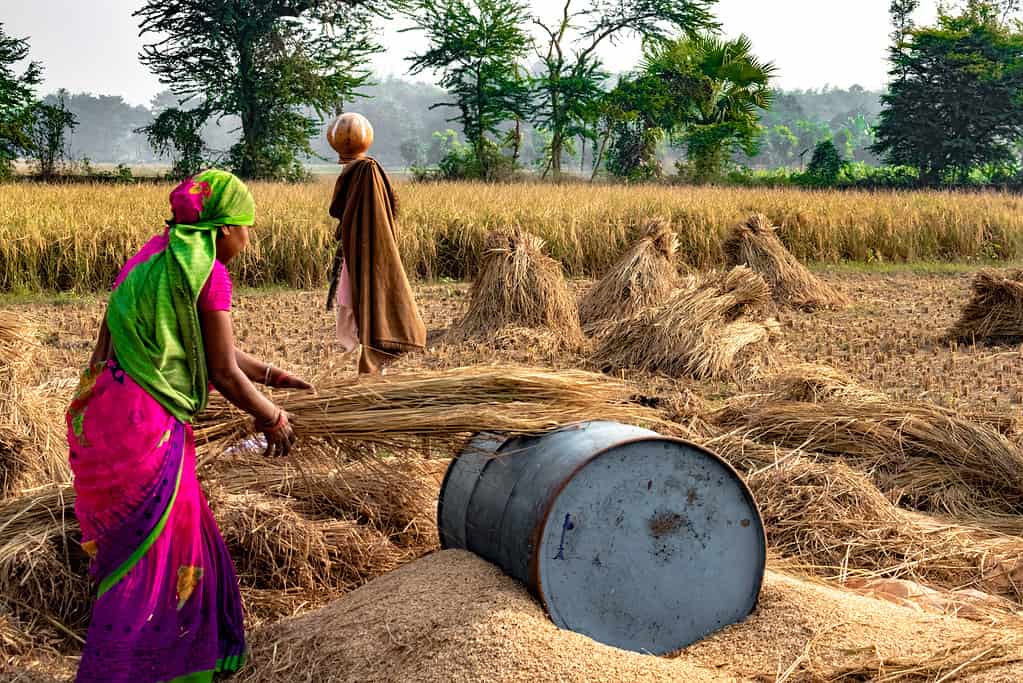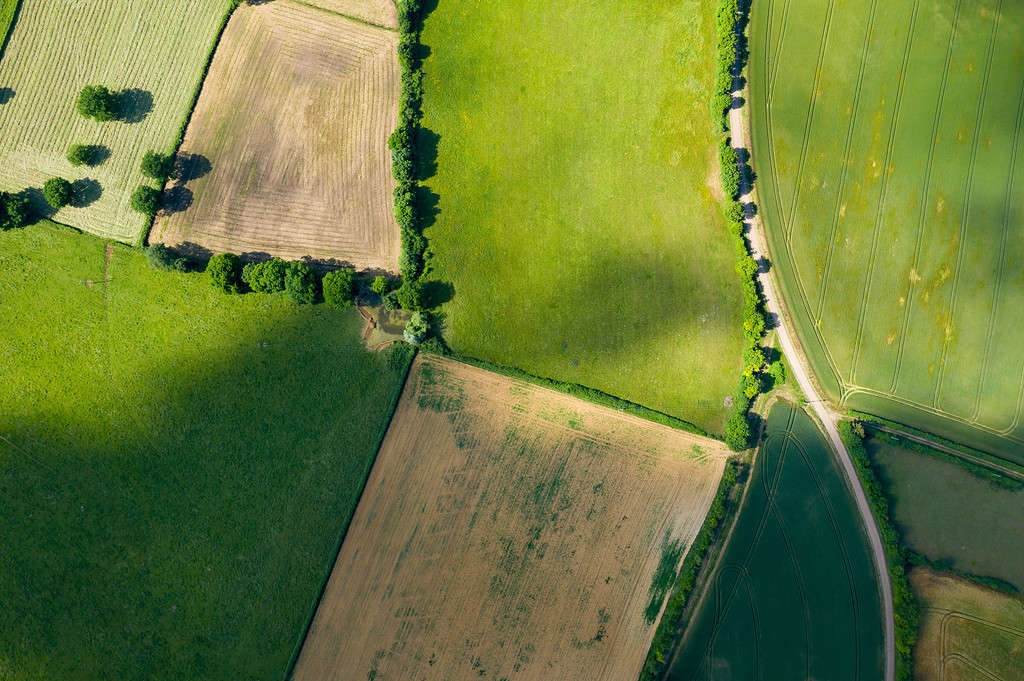The things we can do with wheat are endless. You can make pizza, pasta, bread, biscuits, and even animal feed. Many countries produce billions of tons of wheat every year. But it is thought that grain originated from the Middle East. People living in the region cultivated the grain over 10,000 years ago. From there, the grain was transported and traded to other countries around the world. Today, Middle Eastern countries aren’t the top producers of wheat anymore. Wheat grows better in warmer conditions, where it’s not too cold and not too hot.
Let’s explore the top 10 wheat-producing countries in the world. These countries are diverse and located all over the earth.
1. China

The Asia-Pacific region in the world, which includes China, is the largest producer of wheat.
©Max Zolotukhin/iStock via Getty Images
The largest producer of wheat in the world is China, by no surprise. Wheat farming started around 600 A.D. during the Sui dynasty. Over the years, China’s production increased with China’s northern regions dominating the production of the grain. However, today, there are three wheat-producing regions in the country: the northern and southern winter wheat regions and the southern spring wheat region. Climate change has affected the wheat production in many countries. In China, the heavy rainfall in the spring of 2023 heavily affected the wheat and farmers admitted the quality would be inferior for consumption.
2. India

Uttar Pradesh is the state that produces the most wheat in India.
©Ashish Kumar/iStock via Getty Images
Wheat production in India started around 8000-6000 B.C. Over time, the production of the grain increased. However, it wasn’t until the 1960s that India greatly increased its production of agriculture during the Green Revolution. With the adoption of technological advances and machinery, India sped up their production and now they are the second-largest wheat producer in the world. The state of Punjab, which is India’s highest producer of wheat in the country, was the main leader in the Green Revolution.
3. Russia

The North Caucasus region in Russia produces the most wheat because of its fertile soil and great climate.
©Max Zolotukhin/iStock via Getty Images
Wheat production in Russia accelerated when serfs became emancipated. Russia greatly increased production during this time and accounted for one-third of the world’s production. It was during the rise of the Soviet Union that Joseph Stalin decided to increase agricultural production and other industrialization. At first, farmers and peasants refused, which in effect led to livestock dying off or country-wide famine, where 4-10 million people died. In the 1960s, Russia made a comeback in wheat production and now is the third-largest wheat producer in the world.
4. United States

Kansas and North Dakota are the states that produce the most wheat in the United States.
©David Harmantas/Shutterstock.com
Almost every state in the US produces wheat, however, it is concentrated mainly in the Midwest and mountain states. Wheat production in the 19th century lagged in the US because it would take 10 hours to harvest 200 bushels. However, with the advancement of technology and industrial machinery, the US tripled its production. About 50% of wheat is exported to other countries, 36% is used for human consumption, 10% is used for animal feed, and lastly, 4% is used for seedlings. Most recently, climate change and threats from droughts have affected American wheat production.
5. France

Wheat production is mainly concentrated in two areas in Europe — Western Europe, which includes France, and Eastern Europe.
©Florent MARTIN/iStock via Getty Images
The northern half of France is the region that produces the most amount of wheat. Wheat and agriculture as a whole have had a huge impact on European integration and unity. In the 1950s, after World War II, Europe needed to come together and interlace themselves so another war would not break. The European Economic Community came into force in 1957.
Recently, at the onset of the Russia-Ukraine War, French farmers decided to increase grain production to be more self-sustainable.
6. Ukraine

Ukraine is considered the breadbasket of Europe.
©Michele Ursi/iStock via Getty Images
Ukraine is a leader in European and global grain production. The Russia-Ukraine war, however, has impacted the grain supply and production. Ukraine took a back seat in grain production at the onset of the war, which greatly affected food security around the globe. However, in the past year, the country has steadily increased production again.
7. Australia

Western Australia is the area that produces the most wheat in the Oceanic country.
©JanelleLugge/iStock via Getty Images
Colonists introduced wheat to Australia in 1788 and steadily increased production during the 19th century. A plague of black stem rust completely decimated the wheat fields in the country. Australians had to start over, but eventually, they made a comeback. Exports started in 1845 and with the introduction of modern machinery, farmers greatly increased production. Agronomist William Farrer developed a hardier form of wheat that would be less susceptible to pests and rust, which revolutionized Australian wheat production. Now, Australia is one of the leading wheat-producing countries in the world.
8. Pakistan

The Punjab region in Pakistan produces the most wheat in the country.
©Waqar Hussain/iStock via Getty Images
Pakistani diets contain 60% wheat, which means that grain is an important part of their economy. The harvesting and production of wheat is extremely important for Pakistani food security. The Green Revolution in the 1960s began with the advancement of machinery in India and Pakistan and revolutionized how the country produced wheat. Today, Pakistan dominates world production as being one of the largest wheat-producing countries.
9. Canada

Saskatchewan is the province that produces the most wheat in Canada, often called the nation’s breadbasket.
©todamo/iStock via Getty Images
Colonists introduced wheat in Canada in the 1600s. Slowly, Canadian farmers saw the potential impact wheat had on food and decided to increase production. It was in 1909 that a new type of wheat was developed. The Marquis was a revolutionary variety of wheat because the quality of it was much better than the European varieties. Today, farmers use sustainable agricultural techniques to make a positive impact on the environment. Usually, wheat is planted in summer and by early autumn, it is ready for harvest. Apart from human consumption, Canadian wheat is also used in animal feed, pharmaceuticals, and biofuels.
10. Germany

Bavaria is the region that produces the most wheat in Germany.
©Alexander Raths/Shutterstock.com
Germany’s climate has been the most attractive reason why agriculture thrives in the country. Barley, onions, and wheat grow fairly well all over the country, especially in southern Germany. Thus, Germany has been a European leader in the agricultural industry. In 1957, they joined the European Economic Community to ensure Europe was intertwined in their economies and avoid war in the future. The country mainly exports its wheat to North Africa, western African countries, and Iran.
Conclusion
And there you have it, these are the top 10 wheat-producing countries in the world. The ideal temperature conditions for wheat are warm climates that can’t get too hot. These countries all have varying degrees of climates, but the common thread between them is that they aren’t too cold in climates where wheat can’t grow.
If you find yourself visiting any of these countries, you can make the most of it and visit a field that produces wheat. Or maybe, try foods unique to that country that use wheat. In the US, try some pancakes at a diner. In some regions in India or Pakistan, you can try phulka. And in France, you can get yourself a baguette with French cheese and a bottle of wine. Mmm, what a delicious treat!
The Top 10 Wheat-Producing Countries in the World
| Rank | Country | Metric Tons |
|---|---|---|
| 1 | China | 136.9 million |
| 2 | India | 109.6 million |
| 3 | Russia | 76.1 million |
| 4 | United States | 44.8 million |
| 5 | France | 36.6 million |
| 6 | Ukraine | 32.2 million |
| 7 | Australia | 31.9 million |
| 8 | Pakistan | 27.5 million |
| 9 | Canada | 22.3 million |
| 10 | Germany | 21.5 million |
Thank you for reading! Have some feedback for us? Contact the AZ Animals editorial team.








